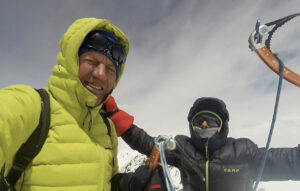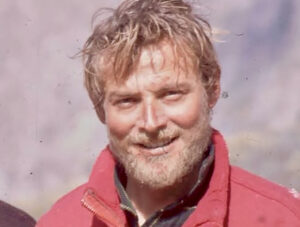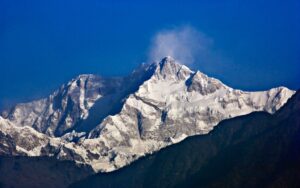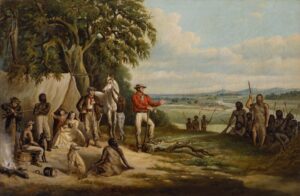On June 3, 1950, French mountaineers Maurice Herzog and Louis Lachenal were the first climbers to set foot on top of an 8,000m peak. They topped out on 8,091m Annapurna I via the North Face, without the use of supplementary oxygen.
“There are other Annapurnas in the lives of men,” Herzog wrote a few years later. Yet Annapurna I remains the main goal for peak collectors and the majority of mountaineers.
Annapurna I by the numbers
From its first ascent until the spring of 2022, the Himalayan Database lists 395 summits on “the Goddess of Abundance”. Of those, 222 ascended without bottled O2. Seventy-two climbers died on the peak, 69 of whom were not using oxygen cylinders.
Between 1950 and 1970, no one ascended this mountain. In the 1970s, 21 people made the summit, most of them without oxygen. The number of climbs stayed steady until the start of the 21st century when activity picked up. Between 2001 and 2010, 74 people climbed Annapurna I (69 without supplementary oxygen), and from 2011 to 2020 there were 115 summiters, 44 without O2.
But then, in the last two years, numbers have increased drastically. A total of 97 summiters are registered in the Himalayan Database and only 11 did not use bottled oxygen.
When Herzog wrote about the other Annapurnas, it was metaphorical. He was referring to other life goals. But there really are other Annapurnas too. They are just not on most people’s radar.

Annapurna South, also known as Annapurna Dakshin, 7,219m. Photo: Sudan Shrestha
The Annapurna massif
Annapurna I has two secondary peaks above 8,000m: Annapurna Central (8,051m) and Annapurna East (8,010m). The Annapurna massif features 13 peaks over 7,000m and 16 over 6,000m. These include Annapurnas I to IV, Annapurna South (7,219m), Khangsar Kang, Tarke Kang, Lachenal Peak, Tilicho Peak, Nilgiri Himal, and Gangapurna, among others.

An interesting shot of Annapurna II from the north. A human face can be seen in the wall. Photo: Lev Yakupov
Annapurna II
Annapurna II (7,937m) was first summited on May 17, 1960, by Chris Bonington, Richard Grant, and Ang Nyima Sherpa. All three men used supplementary O2. The first no-O2 ascent was nine years later, by Kazimir Draslar and Matija Malezic.
Annapurna II has not seen much action recently. It was last ascended in February 2007.
Six climbers have died on this peak, all from fatal falls.

Views from Annapurna III during a Ukrainian expedition in 2021. Photo: Nikita Balabanov/Mikhail Fomin/Viacheslav Polezhaiko
Annapurna III
This peak is a real challenge. Its 7,555m summit had its first ascent on May 6, 1961, by Sonam Gyatso and Manmohan Singh Kohli of India and Sonam Girme Sherpa of Nepal. None used O2. Only 34 people have ever summited Annapurna III, and most of them (27) did not use bottled O2. Nine climbers perished on its slopes.
In 2021, Ukrainians Nikita Balabanov, Mikhail Fomin, and Viacheslav Polezhaiko summited Annapurna III, earning them a special mention in the Piolet d’Or ceremony this autumn.

Annapurna IV. Photo: Furtenbach Adventures
Annapurna IV
Annapurna IV (7,525m) has had more ascents. Germans Harald Biller, Heinz Steinmetz, and Juergen Wellenkamp first climbed it on May 30, 1955 without O2.
Since then, 128 climbers have summited, 121 of them without bottled oxygen. It was last summited on November 13, 2022, by two members of a 14-person Russian team, Alexandr Eliseev and Andrey Dergachev. A key member of the team, Oleg Afanasiev, severely frostbit his fingers, resulting in amputation.
Five climbers have died on the mountain because of avalanches, exposure, or Acute Mountain Sickness. All the victims climbed without O2.
The Fang
A little-known peak, the 7,647m Fang, also known as Varaha Shikhar, lies southwest of Annapurna I, near the centre of the Annapurna Sanctuary. French climber Henri Sigayret wrote in the American Alpine Journal, “Although (it) is the third highest summit in the Annapurna group, it has had less attention from climbers, possibly because its name does not have Annapurna in it.”
Austrian Sepp Mayerl described it as a “sharp rock-and-ice tooth crowning three jagged ridges and serac-covered faces”.

On the south ridge of the Fang. Photo: Soo Seok Park
The Fang was first climbed on May 17, 1980, by Austrians Sepp Mayerl and Hermann Neumair, and Nepali Ang Chopal Sherpa. They climbed from the south via the west ridge.
South Korean Soo Seok Park and Nepali climbers Tsering Sherpa and Wangdi Sherpa successfully made the second ascent on November 29, 2007, without O2. Their team included 16 climbers and they opened a new route via the south ridge and east face.
“I suffered severe high altitude sickness symptoms when we reached Camp 3,” Soo-Seok Park told The Himalayan Journal. “I could not speak because my tongue had gone numb and I had a terrible headache. The summit, which looked just metres away, had disappeared and did not show itself. We climbed another 40m and saw an unbelievable sight in front of us. It was the summit. I embraced the Sherpas and began to cry.”

Views from the summit camp on the Fang. Photo: Soo Seok Park
This was the last time that the Fang was summited. Three climbers have died attempting this peak: in spring 1979, autumn 1979, and autumn 1997.
Other attempts
The Fang has seen a total of nine expeditions. Seven of these were unsuccessful.
Before the successful ascent in 1980, Sepp Mayerl made an attempt in 1979 via the west ridge from the north. The team reached 6,600m when Herbert Obernosterer fell 2,000m onto the north wall. The team aborted the expedition.
“When one man is dead, there is no success for the expedition,” Mayerl said.

Camp 1 on the Fang during its second ascent. Photo: Soo Seok Park
A huge Italian team (20 Italians and three Sherpas), under the leadership of Arturo Bergamaschi, attempted the southeast ridge in autumn 1979. The southeast ridge is very difficult, with a dangerous wall of rotten rock, and the team’s pitons did not hold well. It snowed every day. One of the porters died in a fall. (The Himalayan Database does not indicate his name.) The team’s highest point was 6,350m.
In the spring of 1982, a five-man French party led by Sylvain Sarthou attempted the east face-east ridge-south ridge route. Bad weather forced them to stop at 6,800m. It snowed for 20 days, and the route was full of dangerous seracs. According to their report, the east ridge of the Fang was much like the difficult south face of Annapurna I.

Scott Fischer climbing on the Fang in 1984. Fischer later died on Everest during the 1996 ‘Into Thin Air’ disaster. Photo: Wesley Krause
In 1984, an American team led by Wesley Krause attempted the west ridge. Bad weather stopped them at 7,315m.
A South Korean party led by Kim Jong-Duk tried the east face in 1986. They had to abandon at 5,450m because they lost their equipment in a huge avalanche.
Another South-Korean party attempted the east face-south ridge route in 1991. The team, led by Yu Jae-Hyung, reached 6,350m.
Finally, a third South Korean party targeted the Fang in 1997, climbing the same east face-south ridge route. A harsh wind raked the dangerous ridge, and avalanches fell constantly. On November 8, 25-year-old Kim Yea-Hoon fell 50m and died the following day from his injuries.

Annapurna’s the Fang. Photo: Christian Nesset
There remain some unique unclimbed routes on the Fang. The southwest face is even larger than the Rupal face of Nanga Parbat. This near-vertical wall climbs roughly 4,900m from the base to the summit.






